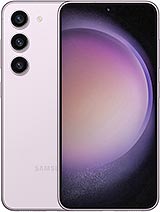Introduction
Asus is keeping the flame alive - otherwise starved for options, compact phone lovers are getting another installment in the Zenfone lineup. The Zenfone 10 brings minimal physical changes to what was already a well-received design, while a mandatory annual chipset upgrade and a few subtle touches on the inside help the 10 keep up with the times.
A lot like on the outside, the changes within might be hard to spot. The bump in refresh rate from 120Hz to 144Hz is only there for you in gaming, and even then, it's hardly a game-changing development. Alongside the new Snapdragon 8 Gen 2, you also get faster memory than the last generation, and the top-spec Zenfone 10 now comes with 16GB of RAM and 512GB of storage (up from 256GB on the 9).
A more tangible change, and one we wouldn't call positive, is the ultrawide camera's lack of autofocus - the Zenfone 9's ultrawide did have that capability, while this new one doesn't. Also gone is the AF support on the selfie camera, a 32MP unit replacing the 12MP one of the old model. With that in mind, the fact that the primary camera remains the same sounds like a positive. Okay, not quite the same - the gimbal stabilization has been improved for this generation, Asus says.
In this context of small upgrades and sidesteps/downgrades, there's still one major addition to this year's spec sheet - it now has wireless charging. This seems like the primary culprit for the 3g increase in weight and the 0.3mm of added thickness, but it's not like the Zenfone has become a choker for it, so the development is most welcome.
Asus Zenfone 10 specs at a glance:
- Body:
- 146.5x68.1x9.4mm, 172g; Glass front, plastic back, aluminum frame; IP68 dust/water resistant (up to 1.5m for 30 min).
- Display:
- 5.92" Super AMOLED, 144Hz, HDR10+, 800 nits (HBM), 1100 nits (peak), 1080x2400px resolution, 20:9 aspect ratio, 445ppi; *144Hz only available in supported games.
- Chipset:
- Qualcomm SM8550-AB Snapdragon 8 Gen 2 (4 nm): Octa-core (1x3.2 GHz Cortex-X3 & 2x2.8 GHz Cortex-A715 & 2x2.8 GHz Cortex-A710 & 3x2.0 GHz Cortex-A510); Adreno 740.
- Memory:
- 128GB 8GB RAM, 256GB 8GB RAM, 256GB 16GB RAM, 512GB 16GB RAM; UFS 4.0.
- OS/Software:
- Android 13.
- Rear camera:
- Wide (main): 50 MP, f/1.9, 24mm, 1/1.56", 1.0µm, multi-directional PDAF, gimbal OIS; Ultra wide angle: 13 MP, f/2.2, 120°, 1/3.06", 1.12µm.
- Front camera:
- 32 MP, f/2.5, (wide), 1/3.2", 0.7µm.
- Video capture:
- Rear camera: 8K@24fps, 4K@30/60fps, 1080p@30/60fps; gyro-EIS, HDR; Front camera: 1080p@30fps.
- Battery:
- 4300mAh; 30W wired, PD3.0, PPS, QC4, 15W wireless, 5W reverse wired.
- Connectivity:
- 5G; Dual SIM; Wi-Fi 7; BT 5.3, aptX HD, aptX Adaptive; NFC; 3.5mm jack.
- Misc:
- Fingerprint reader (side-mounted); stereo speakers.
Asus Zenfone 10 unboxing
The Zenfone 10 doesn't change much in the presentation compared to last year's model - it's the same full-size box, albeit in a different gray hue and with this year's signature triangle-style logos.
Inside the box, you'll get the usual Asus 30W adapter that Zenfones have had since the 7, and a USB-C cable to go with it. Also included is a snap-on protective case that does make the handset take up notably more pocket space, but offers what appears to be a lot of protection.
Design, build quality, handling
Going from 8 to 9, Zenfones kept the overall size and form factor but introduced a new, bold, and blocky design. With the 10, Asus is making no dramatic changes of this sort and the theme is fine tweaks - so fine, in fact, that you may be hard-pressed to tell the two generations apart at a passing glance.
Zenfone 10 (left) next to Zenfone 9
One of those subtle touches is the design of the camera lens housings with the new model opting for smaller metal rings and more glass instead. It's not like the old model looked bad for it, and it's not like the new one necessarily looks better either - it's more of a change for the change's sake.
Depending on how... particular you are about such things (and this reviewer here is), you may appreciate the minimization of the amount of text on the Zenfone's back. The previous generation was somewhat of a minor offender in this respect, while the new one sticks to just a stylized triangular A logo and Asus Zenfone branding, no camera specs, and not even a model name. The two tiny red triangles/arrows that point toward the cameras are a nice touch too.
The polymer back cover is mostly unchanged and it still offers plenty of grip, while being mostly fingerprint-proof (except for the black colorway, which does tend to show some smudges). 'Premium' might not be the first word on your mind, but the material and finish have certainly got character and it's unlike most other solutions out there. It's worth noting that Asus has decreased the amount of visible 'grain' on the finish, though we wouldn't say that's impacted grip or feel in any meaningful way.
We got all colorways in the office, including the brand-new Aurora Green option. The rest of the colors (Eclipse Red, Comet White, Starry Blue, and Midnight Black) are mostly unchanged from the previous generation, though the red and white do have different names.
All but the white colorway come with a black aluminum frame treated to a matte finish, while the Comet White option gets a silver-looking frame. The rings around the camera lenses are styled to match the frame, even if their size has been minimized for this generation.
As was the case on the previous generation, the two separate camera modules stick out by a different amount, so that the Zenfone 10 doesn't wobble quite as much as it would have if the lower-placed ultrawide camera's protrusion matched one of the main cameras.
The cameras actually both stick out a little less than they did on the previous generation, but that's a roundabout way of saying that the phone is ever so slightly thicker altogether. The extra 0.3mm is at least partially accounted for by the newly installed induction coil for wireless charging. It's a difference that's barely perceptible, but one that renders cases for the Zenfone 9 incompatible with the Zenfone 10.
That's the only direction in which the Zenfone 10 has grown - the footprint has stayed at 146.5x68.1mm. A 3g increase in weight is about as negligible as they come to, so the Zenfone remains one of the most compact high-end phones you can get.
Asus does like to point to that 68mm number and compare it to rivals that are wider than 70mm, but that does also mean that the Zenfone has one of the smaller displays on a small phone - not that the 5.9-inch panel is dramatically smaller than the Galaxy S23's 6.1-inch one, for example, but compactness has to come from somewhere.
The bezels around the display aren't the slimmest either though they are at least partially mandated by needing to fit components somewhere without adding extra thickness. Same as last year, the shiny ring around the selfie camera is possibly more irksome than the black border surrounding the display.
Since we made it to these quarters, let's also mention the earpiece that's behind a mesh that just barely eats into the Gorilla Glass Victus layer protecting the display. The 3.5mm jack is also hard to miss in this picture - Asus is persisting with that feature, much to the delight of folks who enjoy wired headphone connectivity.
There aren't really any changes to the placement of the rest of the bits around the Zenfone's perimeter. The bottom is home to the USB-C port, primary loudspeaker ,and main mic. The SIM card slot (with its eject pinhole still nearly into the curved section of the frame) will take two nano SIMs, but no microSD - Asus may be a headphone jack holdout, but the memory card option has been gone since the Zenfone 8.



Bottom stuff • Card tray (red gasket helps with the IP68 rating) • 3.5mm jack and mic hole up top
The hardware controls on the Zenfone 10 are exactly the same as on the 9. That includes the fingerprint-equipped Side Key that's not just your easiest way to secure entry into the phone (for which it does a quietly good job), but can also be set up to do things upon double presses, long presses, and swipes.
Whether it's past experience with the 9 or a change of handling habits, the Zenfone 10's entirely identically placed Side Key is giving this reviewer less trouble than last year's model. Even if you do find it a bit lower than you'd consider ideal, however, the habit will quickly take care of that. And if you're a smartphone leftie, the location is particularly easy to access with a left index finger.
Physically, the Zenfone 10 keeps everything that made the 9 one of the best small handsets on the market. The handset is very pocketable, handles great, and looks quite unlike anything else (well, apart from the previous generation, of course).
Same 5.9-inch diagonal, now up to 144Hz
You won't see major changes in the Zenfone 10's display when ccomparedto the previous generation - it's still a 5.9-inch OLED panel with a 1080x2400px resolution in a 20:9 aspect ratio. The one spec that's been improved is rthe efresh rate, though you won't be getting the 144Hz maximum outside of games - the display is otherwise capped at 120Hz.
There aren't groundbreaking developments in brightness either - we measured 442nits when adjusting brightness manually, and just over 800nits in adaptive brightness mode with the phone placed under bright light. In that sense, the Zenfone 10 is now behind the curve, with competitors reaching a thousand, or even 1200nits. It's not that it's too dim out in the sunlight, it's just that others are brighter.
Color accuracy
Asus groups the Zenfone's color modes under the Splendid option in the display settings, which you may not think to look under if this is your first encounter with a Zenfone. As usual, you get 4 preset color modes with an additional temperature slider, plus an extra 'Customized' mode with its own slider that essentially controls saturation.
All modes but Standard covers a wide gamut, while Standard is tailored for the narrower sRGB color space. Standard got us a very good average dE2000 of 1.8 - an improvement over last year's model, and Cinematic mode was similarly accurate for DCI-P3 content (1.9 average dE2000). Conversely, the default Optimal mode and Natural mode weren't particularly accurate, while also exhibiting strong blue shifts.
HDR and streaming
The Zenfone 10 supports HDR10 and HDR10+ but lacks Dolby Vision capability. We got HDR streams from YouTube, but Amazon Prime Video didn't appear to cooperate, and Netflix didn't give us HDR either. That could very well be dbecausewe've been testing the Zenfone before its official release, so not all certifications and wwhitelistinghave taken place yet. In any case, the Widevine L1 rating does mean you're getting FullHD versions of DRM-protected content, as expected.
Refresh rate
The 144Hz maximum refresh rate is one entry in a short list of generational improvements on the Zenfone 10, but you don't really get to experience it outside of games. For all other use cases, the 10 behaves like the 9 and has the same four modes - the Auto enabled by default and settings for 120Hz, 90Hz, and 60Hz.
The 60Hz and 90Hz modes do lock the refresh rate at the respective setting. Indeed, the 90Hz mode doesn't have the phone dropping to 60Hz when idling, which we found a little odd on the Zenfone 9, but we're no longer surprised now that we see it on the 10.
There's some adaptive behavior in the other two modes, but it's not as fine and granular as on some of the contemporary flagships. A bit unusual (but well in line with the previous generation), the Auto mode will tend to maintain 90Hz most of the time, with no dropping to 60Hz. Unlike the 9, however, we didn't observe the Zenfone 10 thoot to 120Hz for games that support ha igh frame rate - apparently, Asus expects you to pick the refresh rate on a pper-gamebasis in the Game Genie utility.
The 120Hz mode will maintain the nominal refresh rate when you interact with the phone but will switch down to 60Hz when idling. If you're under a certain brightness threshold, there will be no down switching, regardless of battery mode.
High frame rate gaming is possible on the Zenfone 10 - encouraged even. From the Game Genie utility, you can switch the refresh rate irrespective of the global setting, and you can get a frame rate counter as well. It's from here that you get to enable the 144Hz maximum value. Technically, you can call almost any app a 'game' by flicking its toggle in Game Genie, and that lets you enable 144Hz for that app in particular - for example, Chrome, if you so desire.
Asus Zenfone 10 battery life
Asus hasn't changed the battery capacity for this year's Zenfone and the 10 has the same 4,300mAh worth of power inside it. The Snapdragon 8 Gen 2 is a notably more frugal chip than the previous generation, however, and the Zenfone 9 was already a great performer in terms of longevity, so we expected solid numbers from the Zenfone 10 as well.
Indeed, we can report improvements in all active tests, with only standby taking somewhat of a hit. We clocked just over 30 hours of voice calls, which is a 4-hour increase over the 9's result. Almost 4 hours better is the video playback result as well, now at 21 hours and change. In web browsing, we recorded an increase of 1.5h, up to 16:37h.
All these improvements are mostly negated by the 20% shorter standby result (which isn't really half bad in itself). Still, at 109h, the Zenfone 10 does manage a longer overall Endurance rating than the 9, if only by a single hour.
Charging speed
Zenfones have shipped with the same 30W adapter for several generations now, and it's a nice USB Power Delivery unit. In our testing, the power meter peaked at just over 24W, which sounds like a reasonably close number to the rated charging capability.
In our testing, the Zenfone 10 exhibited a slightly different charging curve compared to the 9, taking a little longer to reach 100%, but climbing slightly more quickly at the early stages. All in all, both the 60% at the half-hour mark and the 1:21h time for a full charge are average results among potential rivals of the Zenfone, and on par with the Galaxy S23 numbers.
One of the big new additions to this year's Zenfone is wireless charging. A certification listing at the WPC website was nowhere to be found at the time of writing (nor are they particularly useful anyway), but Asus' specs say the Zenfone 10 should be able to take up to 15W of power through the induction coil on its back.
Among the many proprietary features in the Asus Android build is a set of charging settings meant to increase the battery's lifespan in the long run. One of them is Steady charging, which charges the battery at a flat rate instead of the usual 'super fast in the beginning, way slower at the end approach. There are two levels to it, and the base Steady charging works at 18W, while the Ultra Steady drops that to 10W when using the supplied 30W adapter (that goes further down to 12W and 9W respectively if you have an 18W PD charger).
There's also Scheduled charging which ensures that the battery will stay at 100% the minimum time by doing the final stages of the process just before your alarm goes off or before a predetermined time.
Alternatively, you can set a ceiling to the state of charge of 80% or 90%, so your battery doesn't have to spend any time at that 100% level which Lithium-Ion batteries don't feel too well at. Asus's testing indicates that after 500 charge cycles with the 80% limit, the battery will have only lost 7% of its initial capacity, compared to 15% if you let it go all the way up to 100%. It's useful if you like to keep your phone for as many years as it will last and/or if you're a habitual overthinker. You just need to remember to switch it off when you know you have a long day ahead of you.
Speaker test
The Zenfone 10 has a stereo speaker setup with one bottom-firing unit and another front-firing one at the top that serves double duty as an earpiece. The bottom speaker measures 11x15mm, so it's smaller than the one on the previous generation by a millimeter in each direction. The top unit is the same as before, at 10x12mm. The two speakers switch channels depending on the phone's orientation in the landscape, while the top one gets the left channel when in portrait.


Bottom speaker • Earpiece/Top speaker
Asus' collaboration with Dirac continues and the Swedish sound researchers are responsible for the phone's tuning, with a focus on enhanced bass perception. Sound isn't quite as big as on the Zenfone 9, however, particularly in that lower frequency region. It's okay, it's just that the 9 is boomier than the 10, and in a good way. The Galaxy S23 sounds notably better across most music styles, though we'd still rank the Zenfone 10 higher than the Xiaomi 13 for sound quality.
In terms of measured loudness, the Zenfone 10 is on par with the previous generation and the Galaxy S23 and earns a 'Good' rating in our test. The Xiaomi 13 and the Motorola Edge 40 are a little louder, making it into the 'Very Good' category.
Perhaps around here is a good point to mention that The Zenfone 10's handling of volumes is a bit unorthodox. If you opt for the Asus Optimized UI, you can have certain volumes all linked together and controlled at the same time by the volume rocker or main slider. You can choose to decouple some sounds from the slider, and you can set separate upper limits for each of the linked types of sounds. The in-call volume is always a separate setting.
It's when you opt out of the Asu's slider solution that you get to enable an Outdoor mode. That gives the midrange a significant boost, and the midrange is where loudness lives (as we've heard at least one sound engineer proclaim). So, in this mode, the Zenfone 10 scores an 'Excellent' rating for loudness thanks to a -22.3LUFS result. The flipside is a less pleasing and less 'musical' sound quality.
Android 13 with Zen UI on top, 2 Android OS updates
The Zenfone 10 runs on Android 13 with a layer of in-house Zen UI on top. The Zen UI branding isn't all too prominent and for Asus-specific UI elements we're now seeing the Asus brand itself used more often. "Zen UI" is used in the promo materials, but no specific version has been quoted.
All that is mostly beside the point, though. More important is Asus' promise fof2 OS upgrades and 4 years of security patches. Once again, it's not the longest of uupdatedpolicies, but it's not too bad either.
Asus prides itself on offering plenty of added software functionality masked behind a relatively unobtrusively skinned Android UI. That said, the System preferences menu does offer a nice hub for changing a few key UI elements from the Android defaults to their 'Asus Optimized' versions. You also get that option during the initial setup process, but maybe you're tthetype of person who goes through new phone setup without much thought, so it's nice to have the options well organized and grouped together, to explore at a more convenient time.
The provided settings include several aspects of volume slider control (one of which we already mentioned in the speaker section), the llock screenclock, quick settings layout, incoming call visualization, and pthe ower-off menu.
The UI fundamentals can be largely stock, though the Asu's optimizations above can change some of them. Still, the 'clear all' button in the task switcher is Asus' own and you get that regardless of 'System preferences'.
Nice little in-house touches include folders opening in the lower half of the screen and the app drawer's bottom-placed search bar - single-hand operation isn't just about a physically small handset, but also well-thought-out software.






Lockscreen • Homescreen • Notifications • Task switcher • Folder view • App drawer
A long-standing Zen UI feature is the Smart key - it allows you to assign actions to the power button/fingerprint reader. Double press (which is labeled 'double tap', but you do need to press it) and long press actions can be set to simply launch an app, but you can also choose from an extensive list of commands like changing system settings or setting an alarm, and you can alternatively set either of the two to voice input. Additionally, you can swipe on the sensor to pull down the notification shade, refresh web pages, or control media playback.






Smart Key offers plenty of options
Back tapping was introduced on the Zenfone 9, where a double tap could be set to take a screenshot or perform another action. The Zenfone 10 adds a triple tap to the mix, with the same functionality.
Small as it may be, the Zenfone 10 also has a one-handed mode too, with plenty of customization. In its essence, you swipe downward close to the bottom edge of the screen and get the top half of the UI within easy reach. You can adjust the maximum height of the one-handed mode area so if you have bigger hands, you don't really need to limit your space to just half of the screen, for example. Switching back to normal mode is just as easy - a single tap on the blank area restores rand e-expands the UI.
There's also the edge tool pane that lets you have app shortcuts available with a swipe in from the side. These apps will open in a pop-up window above the rest of the interface which is handy. Twin apps are supported, as well.






Back tap • Back tap • One-handed mode • One-handed mode • Edge tool
The Game Genie utility offers a ton of gaming-related features and functionality, and it's where you need to look if you want to experience that 144Hz refresh rate that the display is capable of. You can track the real-time status of the device and call the Game toolbar offering quick access to certain settings. Settings can be re-arranged, added, or removed.
TThere area bunch of custom apps for handling everyday tasks too. For example, you get an in-house Gallery app, a File Manager, as well as a Mobile Manager utility which serves as a hub for keeping track of memory and general optimization.





Gallery • Gallery • File manager • File Manager • Mobile Manager
Performance and benchmarks
The Zenfone 10 is powered by the Snapdragon 8 Gen 2 and by this time the chip isn't surprising anyone with anything. Qualcomm's latest top-end silicon is manufactured on a 4nm process, features a 1+2+2+3 CPU arrangement ,and comes with support for UFS 4.0 storage and LPDDR5X RAM.
The Zenfone 10 will be available in several memory configurations, starting from 8GB/128GB and maxing out at 16GB/512GB, which is what our review units are. It's worth pointing out that Asus explicitly specifies the 128GB version to have UFS 4.0 storage as well, unlike the Galaxy S23, for example, which uses UFS 3.1 for the base 128GB variant.
As we've come to expect from Zenfones, the 10 features a handful of 'system modes', accessed from the battery settings or from the quick toggles in the notification shade. We ran our benchmarks in the default Dynamic mode (because it's the default one) and the High Performance mode (for obvious reasons). The results varied significantly in GeekBench and Antutu, but there was next to no difference in GFXBench and 3DMark. Then there was a rather significant gap between the two modes when it came to sustained performance, but more on that at the end of the page.
In GeekBench 5, the Zenfone can't quite match the Galaxy S23 in the single-core test, regardless of mode, but it does score on par with the Xiaomi 13 when in HHigh-performancemode. In the multi-core test, the Zenfone just barely edges ahead of the Xiaomi, the two leaving the Galaxy a small distance behind.
Performance under prolonged load does differ substantially depending on which mode the phone is in. In the CPU Throttling test, when operating in HHigh-performancemode, the Zenfone 10 started with higher scores, ramped down performance gradually ,and settled at around 80% of its peak result, only to dip to about 60% a little under 40minutes into the test. After a few minutes of cooling down, it was good for another 7 or 88-minuterun at 80% before another dip to 60% was observed.
In Dynamic mode, the graph turned out very different, starting out from a lower peak and quickly dropping to 60% of it in just 15 minutes where it stayed for the remainder of the test.
In the 3DMark Wild Life stress test, the two modes returned very similar initial scores, but in High-performance mode, the Zenfone posted a stability rating of 69%, while Dynamic mode only managed 50%.
Overall, the two modes have clearly different thermal ceilings and High-performance mode allows the Zenfone to run hotter, and do so for longer periods.






CPU throttling test: High perf • Dynamic • 3DMark Wild Life stress test: High perf • Dynamic
The same-ish main camera, AF gone from the UW
The Zenfone 10 introduces a few changes to the camera system, and we're not quite so sure how to feel about them. For starters, the rear setup is the same in principle - a wide main camera and an ultrawide unit, but no dedicated zoom module - and that's more or less what you can expect in this size. But why, oh, why, did Asus choose an ultrawide module without AF this year, when the Zenfone 9's unit had that capability?
This new ultrawide camera employs an OmniVision OV13B sensor - a 13MP imager with a 1/3.06" optical format, 1.12µm pixels, and a conventional Bayer filter array. OmniVision's spec sheet says the sensor itself does have PDAF capability, but that's apparently not being used in the Zenfone 10's implementation. What was so wrong with the Zenfone 9's ultrawide?
Also gone is the AF on the selfie camera, a new 32MP one replacing the 12MP unit from the previous generation. The sensor here is an RGBW design, or what OmniVision calls RGBC - that's Red, Green, Blue, and Clear pixels, for improved light-gathering capability. It's also, in a way, a 4-cell type of sensor (Quad Bayer in Sony speak), and it bins the information from 4 adjacent pixels and outputs 8MP resulting images.
What remains the same, at least partly, is the primary camera. We say partly because Asus says it's moved to version 2.0 of its 6-axis gimbal stabilizer, though the underlying imaging hardware should be unchanged. That means you get the 1/1.56" Sony IMX 766 sensor - a Quad Bayer design with 50 million 1.0µm pixels. It uses the 2x2 OCL method for its phase detection autofocusing, which makes it sensitive to changes in detail in both principal directions as opposed to the usual left/right only capability of generic dual pixel autofocusing - so you should be able to get faster and more accurate autofocus in more shooting conditions. The lens in front of that sensor has a 24mm equivalent focal length and an f/1.9 aperture.
The camera app sees next to no changes for this generation. The basic operation remains largely the same as before and the same as on any other camera app. Also present is the contextual options pane you can pull out by tapping on the little arrow at the far end of the viewfinder or by swiping down in the viewfinder itself. In basic Photo mode, that's where you'll find the flash modes, aspect ratio, and HDR settings, while in Video you have the resolution, frame rate, and stabilization modes.
The full-res mode for the main camera is found under the 'Camera resolution' menu item in the app settings, where you also get the same aspect options as in the slide-out pane in the viewfinder - we'd like to see the 50MP mode move to that more accessible spot as well.
There's a nice Pro mode too, with manual control over exposure parameters, white balance, and focus. A live histogram is available and focus peaking shows up when you try to focus manually. A neat and somewhat unique auto bracketing feature can do three shots with different exposures 0.5 to 2EV apart.
Daylight photo quality
Daylight photos from the Zenfone 10's primary camera are solid. Some notable changes can be observed compared to the Zenfone 9, particularly in the way the new phone treats skies - the more neutral rendition of the 9 is replaced by a more saturated cyan-leaning presentation on the 10. Greenery is also more saturated and somehow brighter on the 10, giving its outdoor shots more color and pop. We're not entirely fans of how the 10 treats reds in outdoor shots - it leans heavily into a fuchsia type of shift.
Overall though, the 10's colors look more approachable, more universally likable, though the 9's take is closer to reality, we reckon. These differences don't really manifest themselves in indoor scenes, meaning that it's the Zenfone 10's scene recognition smarts that are tweaking outdoor shots to make them more appealing.
Dynamic range is very good, and we got well-exposed shots with good development of the tonal extremes, even in the harsh mid-day summer sun. Outdoor photos do look brighter on the Zenfone 10, even for similar exposure values, but the new phone does also tend to expose a 1/3EV brighter when shooting outside.


Daylight comparison, main camera (1x): Zenfone 10 • Zenfone 9
The 10 also draws random textures with finer detail and a different take on sharpening, making for a more organic rendition of foliage and the like. We are seeing a bit more grain in the new phone's shots, but we'd say it's a well-judged tradeoff between detail and noise.


Daylight samples, main camera (1x)
The 50MP mode on the Zenfone 10 doesn't really bring any detail benefits - photos taken in it actually look pretty soft on a pixel level. These don't have the color enhancements applied, however, so you may like to shoot in 50MP outdoors and downscale yourself for a more restrained look of skies and greenery. You will be sacrificing dynamic range, however - there's no HDR in 50MP mode.


Daylight samples, main camera (1x), 50MP
The 2x zoom mode dials the sharpening up to 11 introducing heavy fringing alongside contrasting edges - a bit more than we're used to. That does result in higher perceived sharpness, compared to the Zenfone 9's 2x shots, and we'd say the 10's 2x images are very usable.


Daylight comparison, main camera (2x zoom): Zenfone 10 • Zenfone 9
The difference in color presentation in outdoor shots continues on the Zenfone 10's ultrawide, which also treats you to lusher greens and deeper blues than the 9 does. The new camera's shots aren't quite as sharp as what the old one delivers, though sharpness is still very good - apparently, the old one was just that sharp. The dynamic range doesn't leave us wanting either.
What does immediately strike us as a downgrade is the lack of autofocus, which makes shooting nearby subjects impractical - take the Vespa shot as a prime example.


Daylight comparison, ultrawide camera (0.6x): Zenfone 10 • Zenfone 9
For more distant subjects, and even indoors at close range, that's not an issue, but the lack of AF robs the Zenfone 10's UW of a large chunk of the usefulness that the 9's unit had.

Daylight samples, ultrawide camera (0.6x)
Low-light photo quality
The Zenfone 10 does have an auto Night mode capability and will notify you in the Photo mode viewfinder when it engages, also letting you disable it right there. The notification icon/toggle appears when the scene's dark enough for the auto to kick in, even if you've disabled it previously, so there's no need to go to settings for it.
In our experience, Photo mode results come out identical with those captured in the dedicated Night mode, when the auto Night mode engages. Conversely, when the auto doesn't engage, the photos are the same as if you disable the auto altogether. The scene-to-scene consistency with which the auto will engage varies between cameras.
Main camera
In the first three scenes below, Auto equals Night mode, while in the next three Night mode didn't kick in automatically, making the dedicated Night mode shot stand out.
In general, having the Night mode processing (whether the auto got you there, or you engaged it manually) will result in superior images, with no major tradeoffs. We're talking about better shadow and lower midtone development, restored highlight detail, and better color saturation. There's also less visible noise.
The one minor complaint you could think of is the increased sharpening that could make some fine random detail appear slightly too overprocessed. That's still a fairly common trait of Night modes and the Zenfone isn't remotely the worst offender in this respect.
With all that in mind, we'd say that we'd appreciate a bit more of a trigger-happy approach for the Zenfone 10's auto Night mode action. Or, as it stands, we'd just recommend shooting low-light scenes in the standalone Night mode.


Low-light samples, main camera (1x): Auto Night mode • Dedicated Night mode • Auto Night off
Side-by-side with the Zenfone 9, things generally looked notably better on the Zenfone 10 with no Night mode action - brighter exposures, and superior sharpness. Still, that's a bit of useless comparison, since we already stated that we'd rather shoot in the dedicated Night mode on the 10 than risk getting a Night mode-less shot.

 Low-light comparison, main camera (1x), Auto Night mode OFF: Zenfone 10 • Zenfone 9
Low-light comparison, main camera (1x), Auto Night mode OFF: Zenfone 10 • Zenfone 9
Going for the standalone Night mode levels things up to a great extent, though we'd still give the nod to the new model, particularly in very dark scenes. There's also the fact that, while not entirely dependable, the Zenfone 10 was more eager to engage in Night mode on its own than the 9.


Low-light comparison, main camera (1x), Night mode: Zenfone 10 • Zenfone 9
The main camera, 2x zoom
At 2x zoom, the auto Night mode was even more reluctant to kick in on the Zenfone 10. Then there's the matter that there's no 2x toggle in the actual Night mode, forcing you to pinch (or tap and slide) to zoom in, making shooting at 2x somewhat of a nuisance at night.
We persevered and it was worth it - Night mode shots at 2x (the second column below) generally have better dynamic range and much-improved shadow development and sharpness in the darker areas.

 Low-light samples, main camera (2x zoom): Auto Night mode • Dedicated Night mode • Auto Night off
Low-light samples, main camera (2x zoom): Auto Night mode • Dedicated Night mode • Auto Night off
Ultrawide camera
The ultrawide is apparently no good on its own in the dark - the Zenfone 10 struggles to get any sort of usable exposure with its ultrawide and gets you pitch-black shadows and just some specs of detail around light sources.


Low-light samples, ultrawide camera (0.6x)
It's great news then that the auto Night mode tends to kick in pretty much every time and saves the day (the night?). It delivers vastly improved exposures and dramatically widens dynamic range, while also restoring color saturation. A relatively minor issue is the orange color cast we got with certain types of lighting.


Low-light samples, ultrawide camera (0.6x), Auto Night mode
Complicating comparisons to the Zenfone 9 is the fact that it wasn't quite as eager to do auto Night mode on the ultrawide, so we'll put up side-by-side shots in the dedicated Night modes. The 10's ultrawide does have a slightly wider dynamic range, but then the one on the 9 is doing a better job with white balance. With detail levels being generally similar, there's no clear winner here.


Low-light comparison, ultrawide camera (0.6x), Night mode: Zenfone 10 • Zenfone 9
Once you're done with the real-world samples, head over to our Photo Compare tool to see how the Asus Zenfone 10 stacks up against the competition.


Asus Zenfone 10 against the Galaxy S23 and the Xiaomi 13 in our Photo Compare tool
Portraits
While the Zenfone 9 would shoot portraits at something like a 35mm equivalent focal length (let's call it 1.5x zoom), the Zenfone 10 offers you two options - the main camera's native field of view (1x), as well as a zoomed-in 2x mode.
The phone does a good job of picking out subjects from the background, particularly at 1x, where it even managed to not mess up the scene with the wooden wall paneling, which trips up a lot of handsets.
Selfies
Selfies on the Zenfone 10 come out at 8MP, which is a downgrade from the Zenfone 9's 12MP images, though we do consider 8MP to be a perfectly okay resolution for the purpose. The detail in the Zenfone 10's selfies is very good and the dynamic range is great. Colors are pleasing in outdoor scenes, but the phone did struggle with the auto white balance indoors, producing cold images and marring what could have been a great overall result.
Selfie samples
The Zenfone 9 is actually at least a little bit better with its indoor white balance, though the 10 fares better with colors out in the sun. The 9 does have the upper hand when it comes to detail, but it's also grittier in its rendition of it.
What is a principal advantage of the older model, however, is its autofocusing capability, which lets you capture close-up selfies, for when you want to make silly faces or something.
Selfie camera comparison: Zenfone 10 • Zenfone 9
The one possible redeeming quality of the new selfie camera (and, we imagine, at least partially the reason why Asus went with it) is that the RGBC sensor could have better low-light performance, even though it's a slightly smaller size. This does indeed appear to be the case, with the Zenfone 10's selfies coming out sharper and with better definition in dim conditions than what the Zenfone 9 captures. Even so, we're not sure that offsets the new module's lack of AF and limited video recording options.
Video recording
The Zenfone 10 can record video at up to 8K24 with its main camera and it can also do 4K30 and 4K60 with that module. The ultrawide is capped at 4K30 - the new module has brought about that limitation too, while the Zenfone 9 could do 4K60 with its ultrawide.
Another downgrade is the selfie video capability, which maxes out at 1080p30 (or 720p60) - the Zenfone 9 was good for 4K30 and 1080p60.
Switching to a more positive tone, the 4K capture from the Zenfone 10's primary camera is actually very good. The 60fps footage (75-92Mbps bit rate) is ever so slightly sharper than 30fps (59-62Mbps) but both modes resolve great detail. We're getting good dynamic range and plenty of contrast, even though a slight boost of the shadows wouldn't hurt. The white balance is on point and the overall color rendition is really pleasing.
It's not entirely so on the ultrawide - it delivers over-the-top levels of saturation, though it's not entirely objectionable in its presentation. That is to say, if given the option, we'd certainly tone it down, but we can live with it as is. The picture is similarly contrasty but shadows don't look quite as deep as on the main cam, so bonus points for the ultrawide. A few more of those are awarded for the amount and quality of detail in 4K clips - that's one of the better showings from an ultrawide, even more so considering the relatively unassuming piece of kit that it is.
Circling back to the main camera for some zoom action, clips look pretty good from afar and not terrible when viewed at 1:1, though their upscaled nature is hard to hide.
In low light, the Zenfone 10's primary camera does a solid job too. Its footage does tend to be on the noisy side, but it's also sharp and detailed, which is a trade-off we can appreciate. Shadows are well developed and highlights are decently contained for the circumstances.
That high praise does not extend to the ultrawide camera, sadly. It can't expose brightly enough at night and returns deep, dark shadows and an overall soft picture.
Regular 'Adaptive' mode stabilization on the main camera of the Zenfone 10 is properly spectacular in both 4K30 and 4K60. The walking shake is ironed out proficiently, the pans are smooth and if you're just pointing the camera in one direction, it looks like it's on a tripod.
It's a bit more of the same on the ultrawide, even without the gimbal action.
We don't doubt that the Zenfone 10 can stabilize footage when running, and depending on the surroundings you can get solid videos even without resorting to the HyperSteady mode (which will force you to use 1080p resolution). In our overgrown park path, the phone did put up a great fight against all the fine detail in the foliage that it had to 'stabilize' though some of the heavy stompings of this reviewer did end up in the final footage.
The ultrawide struggled a bit more this time, with a noticeable shake from the moments the feet hit the ground - so that gimbal is helping the main camera a lot.
The HyperSteady mode doesn't necessarily help in these circumstances, so the sacrifice in resolution and overall quality doesn't seem warranted. Perhaps in a more open environment, it would make a bigger difference.
Here's a glimpse of how the Asus Zenfone 10 compares to rivals in our Video compare tool. Head over there for the complete picture.


Asus Zenfone 10 against the Galaxy S23 and the Xiaomi 13 in our Video compare tool
Competition
The Zenfone 10 is all about pocketability, and while it does things in its own way, there are alternatives if you're looking for a compact high-end phone. With a starting price of €800 for a base 8GB/128GB version and €50 extra for a more sensible 8GB/256GB spec, the Zenfone is not unreasonably priced, but it's hardly a bargain either. Let's explore the options.
Zenfone 10 (left) next to Zenfone 9
It's more logical here than usual to start with the previous generation. The Zenfone 9, while still available, will save you €100 for a matching memory configuration - possibly more, depending on who you ask and when. Besides the money in your pocket, the 9 will give you more versatile ultrawide and selfie cameras (thanks to the AF on both, but there are also the additional video modes - 4K selfie videos and 60fps ultrawide capture). You'll be missing out on the latest chipset and while that's hardly a dealbreaker, the wireless charging on the 10 may be the one feature that justifies the premium. If, on the other hand, you're looking at the 10 as a potential upgrade path from the 9 you already own, you'd have some serious rationalizing to do - it's just too small of a step forward.
The Galaxy S23 comes as another obvious alternative. Samsung's latest compact sort-of-flagship packages more phones into less volume (since we're talking from the perspective of compactness), but still doesn't feel as small as the Zenfone 10 - maybe it's the nearly 3mm of extra width. The Galaxy is the more versatile cameraphone since it has a telephoto unit and a more capable selfie camera (though still no AF on the UW), and that could settle it right there. A nicer display, slightly better speakers, and Samsung's software (DeX, 4 years of OS upgrades to the Zenfone's 2) don't hurt either. By now, the S23 has settled at under €700 for a 128GB version and around €750 for the 256GB variant, and with these numbers in front of you, you really must be wanting that headphone jack to go Zenfone.
At under €800 for a 256GB spec, the Xiaomi 13 is another possibility. Just like the Galaxy, the Xiaomi also has a telephoto camera and a superior display, plus it charges notably faster, giving the Zenfone a hard time on some of the fundamentals. It's a bit more of a full-size device though, the Xiaomi, and it weighs a bit more too, which may disqualify it from Zenfone comparisons if absolute pocketability is a top priority.
And while we're there, perhaps the Motorola Edge 40 could satisfy those. With a 6.55-inch display, it's hardly small, but thanks to its curved edges, thinness, and low weight (as much as the Zenfone), it does 'compact' in its own way - a better way, if you consider a philosophical display-to-bulk ratio. The Moto has faster charging, AF-capable UW, a 144Hz display that you can use at 144Hz, and a 'Ready For' PC-like capability. And you can get that for €200+ less than the Zenfone's price. But there are counterarguments - while plenty powerful, the Moto's Dimensity 8020 is no SD 8 Gen 2, and, well, the Zenfone 10 has a 3.5mm jack unlike the Edge 40.
Apple is no stranger to the 'compact high-performance' type of handset either, by the way - offering solid options if you're OS-agnostic. The 13 mini goes for €800, it's nearing 2 years old and has meh battery life, but is smaller than pretty much everything else, Zenfone 10 included, in every metric and will disappear in your pocket - if that's what's most important to you, then the mini has a case. If you're more into a properly functional form factor that still doesn't take up an entire pocket, the iPhone 13 proper will get you that, albeit at a premium over the Zenfone.






Asus Zenfone 9 • Galaxy S23 • Xiaomi 13 • Motorola Edge 40 • iPhone 13 mini • iPhone 13
Verdict
The Zenfone 10 continues in the footsteps of the 8 and the 9 and brings heaps of performance into an easily pocketable package. Its small size doesn't get in the way of achieving excellent battery life, the Snapdragon chip isn't all too bothered by the compact body, and there was room for the usual headphone jack, but also for the addition of wireless charging.
All that is great, but there's just not a whole lot of new stuff about the Zenfone 10, and some of the new stuff rubs us the wrong way. We're not entirely sure that the gaming-only 144Hz refresh rate on the display counts, and we most definitely aren't thrilled about having to change the camera section heading from 'AF all around' to 'AF went'. And while allowances can be made for the absence of a zoom camera on a phone that small, that argument wears thin next to competitors with proper triple-cam setups.
We're not saying that getting the Zenfone 10 is a bad idea. It remains part of a relatively short list of phones catering to customers prioritizing compactness over everything else. But alternatives exist, and a lot of them make more sense. Like even the previous generation of the very same lineup.
Pros
- Standout styling, IP68 rating.
- Excellent battery life, wide battery care feature set; now has wireless charging.
- Headphone jack, solid speakers.
- Fastest Android chipset on the market, solid sustained performance as these go.
- Wonderful video stabilization.
Cons
- Maximum display brightness is below the standards of the day.
- 2 OS updates aren't a lot.
- Autofocus went from the selfie and ultrawide cameras.
- No telephoto camera.























































Enregistrer un commentaire